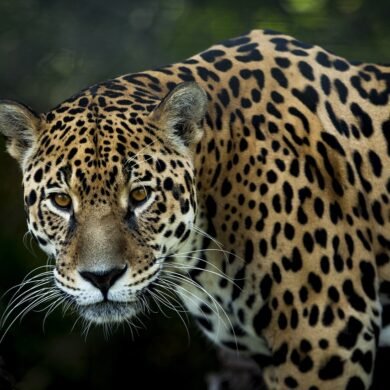The jaguar is a powerful and beautiful member of the cat family which ranges from northern Argentina to the southern United States. [Click here for the sound of a jaguar growling] It has a beautiful pelt and is similar to a leopard but is more powerfully built with a deep chest and stocky legs.
It both climbs and, unusually for a member of the cat family, swims well. Including its tail a male jaguar can be up to nine feet long and weigh up to 350 pounds. They are solitary animals and meet up only to mate.
It is the most powerful predator in Central and South America. It hunts most forest and jungle animals and will also hunt farm and domestic animals. Amazon Indians say that the jaguar fishes using its tail for bait and it certainly does catch fish. Biologists say that the jaguar’s tail accidentally dangles in the water and this attracts fish which the jaguar then catches.
While other large cats kill by biting the neck or throat the jaguar often bites through the skull. It has a reputation for ferocity but there are few documented accounts of attacks on humans. There are many stories of jaguars following humans through the jungle for many miles but it has been suggested that they are merely escorting them off their territory and not stalking them. Amazon Indians tell of jaguars coming out of the jungle to play with their children. However, the jaguar is definitely a man-eater. The anthropologist Napoleon Chagnon who has studied the Yanomamo of the Venezuelan-Brazil border says that he was stalked by jaguars a number of times and, on one occasion, was nearly a meal for one which had come into the camp in the early hours of the morning. He reported that in August of 1990 a jaguar attacked a party of armed Yanomamo in a village he was studying and killed three of them. The jaguar dragged one of them off and ate most of him. On another occasion a jaguar attacked a Yanomamo village and injured many before being speared to death.
However, there is now a need to protect the jaguar. It was hunted for its beautiful coat and it is estimated that during the 1960’s and 70’s anywhere up to 18,000 a year were killed. Now the deforestation of much of south and central America is threatening its habitat. Ranchers nowadays kill the jaguar because they say it is a major predator of their livestock.
The Olmecs and Mayans made use of the jaguar in their art and religion in which it was often combined with human characteristics to produce a were-jaguar. The Olmecs in particular often combined the features of jaguars with those of human infants. The jaguar was also linked with Tlaloc, the god of rain. Men were carved with jaguar mouths. The Sun God, in his journey beneath the earth at night, became the Jaguar God of the Underworld.
To the Aztecs the jaguar was the animal disguise of Tezcatlipoca the god responsible for leading Quetzalcoatl, the Feathered Serpent, astray and introducing the practice of human sacrifice. The jaguar symbolized rulership to many of the Indians of MesoAmerica. It is interesting that in one of the Yanomamo stories about the jaguar he is, essentially, human and so the eating of humans is akin to cannibalism. It may be that a similar dynamic was at work with the cannibalism of the Aztecs and other tribes and this later identification with the jaguar had its origin in the traumatization of the early inhabitants by this ferocious predator. The Aztecs had two classes of warriors known as Eagle and Jaguar. They were renowned for their ferocity and valor like their animal namesakes. However the jaguar costumes that the Aztec warriors wore into battle were not made of jaguar skins but of feathers.
In May, in the Mexican state of Guerro, Indians today still dress up in jaguar costumes and, wearing leather masks, the men fight each other in ‘duels’ using heavy whips. The meaning of this is a sacrifice and penance to bring the rain.
Looking at the photos of the jaguars you can see both the beauty, the grace, and the ferocity of the animal and understand why it was such a potent symbol of both cosmic and political power for the Indians of MesoAmerica.
by Michael Sones















